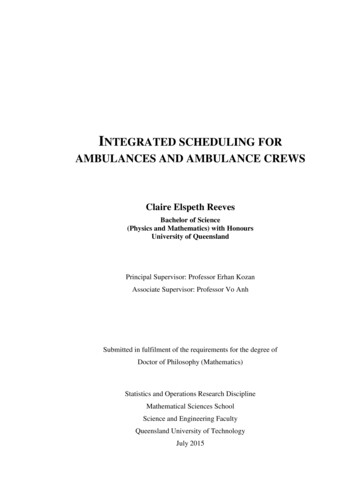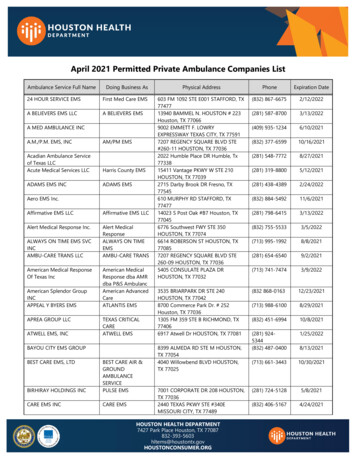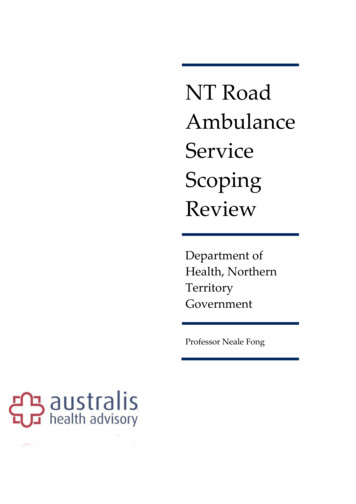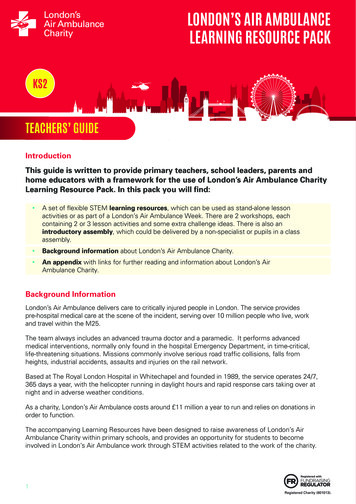
Transcription
LONDON’S AIR AMBULANCELEARNING RESOURCE PACKKS2TEACHERS’ GUIDEIntroductionThis guide is written to provide primary teachers, school leaders, parents andhome educators with a framework for the use of London’s Air Ambulance CharityLearning Resource Pack. In this pack you will find:yA set of flexible STEM learning resources, which can be used as stand-alone lessonactivities or as part of a London’s Air Ambulance Week. There are 2 workshops, eachcontaining 2 or 3 lesson activities and some extra challenge ideas. There is also anintroductory assembly, which could be delivered by a non-specialist or pupils in a classassembly.yBackground information about London’s Air Ambulance Charity.yAn appendix with links for further reading and information about London’s AirAmbulance Charity.Background InformationLondon’s Air Ambulance delivers care to critically injured people in London. The service providespre-hospital medical care at the scene of the incident, serving over 10 million people who live, workand travel within the M25.The team always includes an advanced trauma doctor and a paramedic. It performs advancedmedical interventions, normally only found in the hospital Emergency Department, in time-critical,life-threatening situations. Missions commonly involve serious road traffic collisions, falls fromheights, industrial accidents, assaults and injuries on the rail network.Based at The Royal London Hospital in Whitechapel and founded in 1989, the service operates 24/7,365 days a year, with the helicopter running in daylight hours and rapid response cars taking over atnight and in adverse weather conditions.As a charity, London’s Air Ambulance costs around 11 million a year to run and relies on donations inorder to function.The accompanying Learning Resources have been designed to raise awareness of London’s AirAmbulance Charity within primary schools, and provides an opportunity for students to becomeinvolved in London’s Air Ambulance work through STEM activities related to the work of the charity.1
LONDON’S AIR AMBULANCE LEARNING RESOURCE PACKTEACHERS’ GUIDEKS2These resources have been:yDesigned to allow flexible usage either as stand-alone activities, assemblies or as a frameworkto raise awareness during a London’s Air Ambulance Week with parents and home educators.They are designed to be used by school leadership, teachers and groups of pupils, with classroomteachers being the target of the Learning Resources. Parents and home educators can also usethe resources to provide further learning opportunities outside the classroom.yFor use as part of a scheme of work, curriculum links are provided at the end of this guide,as well as additional links that teachers and practitioners may find useful related to the London’sAir Ambulance Charity and its work.yWritten by teachers for teachers across KS2 STEM subjects, Geography and PSHE. Eachhas been planned as a 45-minute suite of activities to incorporate within a ‘whole’ lesson andincludes a short teacher presentation with relevant pupil information and supporting presenters’notes which have been included within this guide.yThe supporting activity sheets complement and reinforce information from the presentation andincludes key messages and facts. They are designed to be fun, to spark discussions, to stimulatecuriosity and to raise further questions where possible.yDue to the cross-curricular nature of the subject matter, teachers may wish to combine morethan one activity into a charity focus day, or may wish to use one activity in a shorter context,such as PSHE, year assembly or form time.yBoth workshops and their activities can also be used as a scheme of work, either across therelevant subjects as a whole-school London’s Air Ambulance Week Charity focus, or in onesubject across a number of lessons, as a cross-curricular STEM module.Planning:The suggested lessons are divided into two workshops and an assembly presentation to helpincorporate these activities into your schemes of work, classes or assemblies. Also includedis guidance on which STEM subjects align with each activity. Geography and PSHE links arealso included.2
LONDON’S AIR AMBULANCE LEARNING RESOURCE PACKTEACHERS’ GUIDEKS2Assembly/Presentation:The colourful power-point presentation provides an entertaining and informative introduction to thework of the of London’s Air Ambulance Charity. It could be used as an whole-school assembly orclass assembly, as part of PSHE lessons, for cross-curricular work, as part of a charity initiative, oras home learning.We have provided comprehensive and detailed notes for teachers and parents to accompany eachimage so that, depending on age, ability, curiosity and time available, you can add further informationin response to their questions. It is recommended that, before running any of the workshop activitieswe have supplied, the children watch and discuss this introductory presentation.Slide1NotesLondon’s Air Ambulance is a Charity, formed in 1989.Ask the children to work out how many years have passedsince 1989; The vision: To end preventable deaths inLondon from life-threatening injuries;The mission: To save lives through rapid response andcutting-edge technology and care.The aim: To take the hospital to the patient when there isnot time to transport the patient to hospital to begin theirtreatment.2Can the children spot the Shard? (It is the tallest buildingin the picture.)Ask if they have ever been there.Ask them to guess how high it is. (310m)Would they like to be a pilot? Why?By comparison, the Eiffel Tower in Paris is taller, at 324metres, whilst the London Eye is only 135m.Background facts: Around 20% of patients treated areflown to a Major Trauma Centre (MTC) hospital after theirtreatment at the scene; the other 80% transported to aMTC by a London Ambulance Service road ambulanceaccompanied by London’s Air Ambulance medical team.3What skills would you need to be part of this crew?Information will appear on 2nd click on the PPTCrew includes:- A doctor or consultant with experience in EmergencyDepartments, Intensive Care or Anaesthesia- A senior paramedic- Two pilots; one flying, 1 navigating.- All of the crew undergo a tough selection process andextra specialist training before they can fly on missions.- Key personal skills required: What do the children thinkwould be the skills needed?- (Answers could include: the ability to work wellin teams, to remain calm and clear-thinking underpressure, resilience, a high level of training andexperience, effective and excellent communicationskills, kindness, respectfulness.)3
LONDON’S AIR AMBULANCE LEARNING RESOURCE PACKTEACHERS’ GUIDEKS2Slide4NotesWhere do you think this helipad might be? Informationwill appear on 2nd click on the PPTThe roof of the Royal London Hospital, Whitechapel is ontop of the 17th floor. The height of the helipad is 85 metresand is the highest rooftop helipad in Europe.Imagine you are one of this amazing crew. How would youfeel if you were one of the team on board who are aboutto take off to save lives?(Listen to their responses.)5This Mission Map shows how many people London’s AirAmbulance treated in 2019 - a total of 1730 patients.Show the children the green arrow on the map, explainingthat this is the location of the Royal London Hospital, E11FR. Ask them to look for the white, wavy line, whichmarks the position of the River Thames.Ask if they think the Royal London Hospital is north orsouth of the River Thames.(It is North.)Can they name the motorway that runs around London?(It is the M25.)Further information and questions could be asked:Can anyone guess how far it would be to travelcompletely around the M25?(117 miles.)Who can estimate how long it would take to drive aroundthe M25 by car?(At speeds of 60 to 70 mph, it would take around 2 hours, butif there is congestion, it could take between 3 to 4 hours.)Remind pupils that 1730 patients were treated in 2019 byLondon’s Air Amb
London's Air Ambulance could land here, in any London park, or even in Trafalgar Square or outside Buckingham Palace if it is near to a patient in need. 14 Read the statistics in red and then see if they can identify the crew members. On the second click, the answers will appear in: doctor, fire crew, doctor, fire crew, paramedic and pilot.
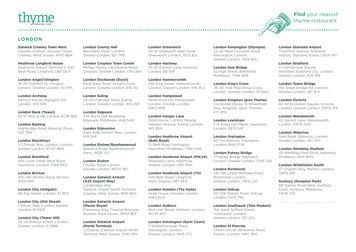
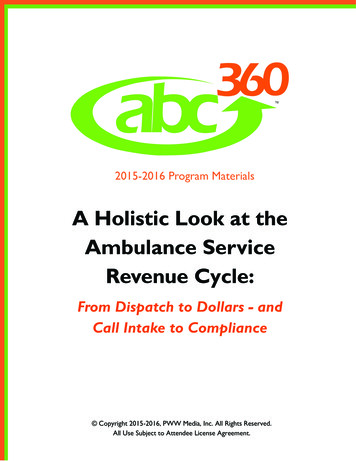
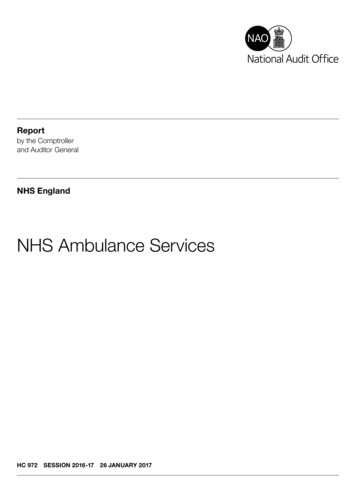
![MOH STANDARDS FOR EMERGENCY AMBULANCE SERVICE (2017) [Updated 21 Nov 2018]](/img/51/emergencyambulancestandards.jpg)

